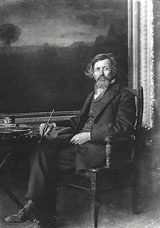Inness began his career in 1841 as an apprentice in a map engraver’s firm in New York City, where he worked for one year. The only formal training he received came from Regis Gignoux. Following that, Inness opened his own studio in 1845, the same year he first exhibited at the American Art Union. He first exhibited at the National Academy of Design in 1844 and continued to do so for the rest of his life. He also exhibited frequently at the Brooklyn Art Association.
He was elected a member of the Century Association in 1853 and resigned in 1890.
Inness seems to have had an inner restlessness, for he moved frequently and made numerous trips to England, Italy, and France, where he was exposed to the Barbizon School. Following Inness’s exposure to the Barbizon School, his compositions lost the tight linearity of his early work.
Inness was fond of New Hampshire and was at the Kearsarge House in 1875 and kept a studio on the second floor of the North Conway Academy for several years before 1876. The last sixteen years of his life included trips to Mexico City, Cuba, Florida, the Yosemite Valley, and Europe.
Of his painting and of an artist’s obligations, Inness said, “A work of art does not appeal to the intellect. It does not appeal to the moral sense. Its aim is not to instruct, not to edify, but to awaken an emotion.” Such a philosophy is a direct contradiction of the aims of earlier landscapists such as Thomas Cole and Alvan Fisher, and of the topographical clarity of David Johnson and Asher B. Durand.
Signatures
- 1875
- 1875
- 1888
Photo Credits
Charles O. Vogel
Reference
New Hampshire Scenery




